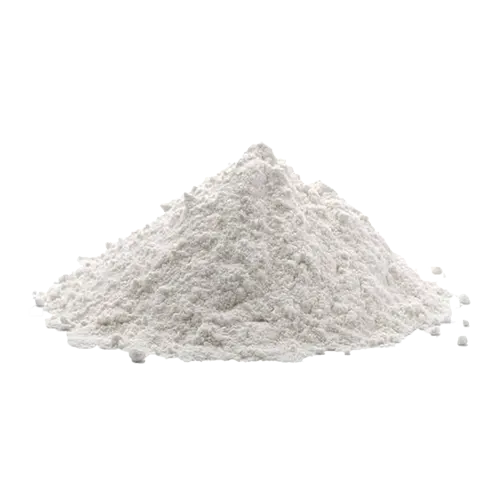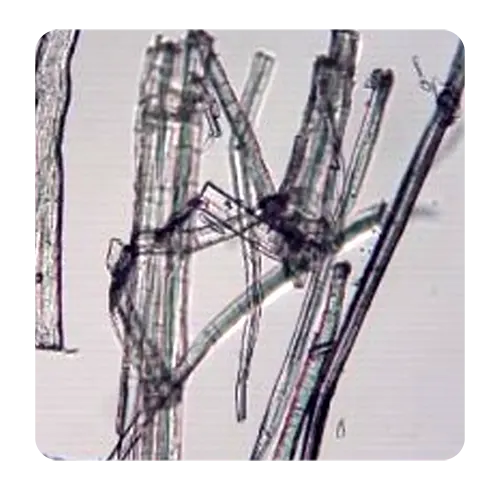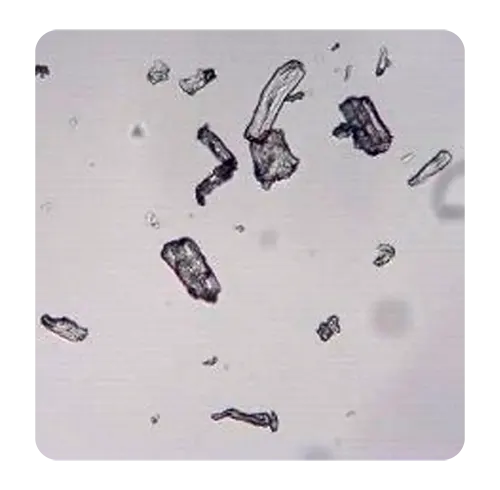
Green & Growth®
G-Celluloses
La celulosa es el principal material de construcción de la naturaleza.
Es el biopolímero natural más abundante del planeta, capaz de sustituir a materiales de origen fósil a gran escala.
GREEN & GROWTH®
G-Celluloses
Green & Growth desarrolla celulosas con diferentes tamaños de partícula y características que las hacen adecuadas para distintas aplicaciones. Pero todas ellas comparten unas características comunes que las hacen únicas:
-
Son de alta pureza
Proceden de cultivos fibrosos, considerados una fuente de celulosa de alta calidad por sus características a nivel molecular.
-
No proceden de la madera
Por lo que las G-Celulosas evitan la deforestación.
-
No contaminan
Ya que no se utilizan sustancias nocivas durante su proceso de purificación. Purificadas gracias a un método de quimio-termo-tratamiento innovador sin ninguna sustancia tóxica, a diferencia de los procesos tradicionales de pulpeo.
-
Los procesos tradicionales de pulpeo
Como el método Kraft, utilizan ácidos inorgánicos y compuestos clorados para los procesos de deslignificación y blanqueo, Green & Growth ha optado por una fibra lignocelulósica de partida con un contenido mínimo de lignina que permite el uso de tratamientos sostenibles y escalables.
-
Puede considerarse la primera celulosa verde
Por su materia de partida verde y su proceso de producción verde.

G-Cellulose
Pulpa fibrosa de celulosa verde de alta pureza. Suministrada como polvo seco.
Aplicaciones
Papel de filtro para uso técnico/laboratorio. Industria química para derivados de celulosa. Aditivo en industria alimentaria. Tejidos no tejidos, tejidos sintéticos como viscosa, lyocell, etc.

G-Microcellulose
Celulosa microcristalina verde, con una pureza superior al 95%.
La G-microcellulose de Green & Growth se produce sin ninguna sustancia tóxica, lo que la hace apta para un uso alimentario y farmacéutico.
Aplicaciones: Comprimidos farmacéuticos. Excipiente o aditivo para la industria farmacéutica y alimentaria.

G-Nanocellulose
Nanocelulosa verde con una pureza superior al 95%.
NANOCELULOSA: Material del Futuro
La nanocelulosa es la principal candidata para la revolución tecnológica de materiales ya que tiene el potencial de mejorar las capacidades técnicas de las fibras celulósicas cuando es incorporada en productos como biocomposites o materiales de construcción.
En su forma aislada exhibe propiedades únicas:
- Mecánicas, como su alta resistencia y elasticidad.
- Térmicas, como su alta estabilidad térmica con bajo coeficiente de expansión.
- Reológicas, como su alto módulo de almacenamiento.
- Ópticas, como su alta transparencia.
- Físicas, como su peso ligero.
- Químicas, como su alta superficie específica, su alta reactividad química, su biodegradabilidad y su biocompatibilidad.
APPLICATIONS
La nanocelulosa tiene múltiples aplicaciones potenciales en la industria alimentaria, embalaje, purificación de agua, fabricación de papel, biomateriales, y en el sector tecnológico, para la fabricación de productos como supercapacitadores o células solares.
Se prevé un enorme crecimiento de su mercado mundial por su potencial para sustituir recursos poco sostenibles u otros que se postula que llegarán a ser limitantes, como el litio.
Polymers reinforced with natural fibers have become one of the most popular methods for improving the mechanical characteristics and sustainability of polymers.
The incorporation of cellulose in its various forms, such as lignocellulosic fibers, cellulose microfibers, cellulose nanofibers, or crystalline nanocellulose, significantly enhances the mechanical properties of biocomposites.
La incorporación de nanocelulosa potencia las propiedades únicas de las fibras naturales, como un bajo peso, un alto módulo elástico, estabilidad dimensional, bajo coeficiente de dilatación térmica, resistencia a la tracción y el alargamiento en la rotura, además aporta mayor transparencia e impermeabilidad.
Nanocellulose can be applied to various plastic matrices such as PP, PET, PLA, PVA, rubber, tires, or other materials such as natural rubber.
La nanocelulosa tiene la capacidad de convertir los dispositivos electrónicos en biodegradables. Actualmente, las aplicaciones de la celulosa en el campo de la electrónica se están expandiendo en ámbitos que van desde el aislamiento hasta el almacenamiento de energía, pantallas, dispositivos semiconductores e incluso células solares.
En los últimos años, la electrónica verde basada en biopolímeros celulósicos se complementa con generadores de energía livianos, portátiles y flexibles basados en nanocelulosa para proporcionar energía a la electrónica portátil mediante la recolección de energía mecánica en aparatos triboeléctricos y piezoeléctricos. La enorme ventaja ecológica de los dispositivos electrónicos y termoeléctricos basados en nanocelulosa es su inherente biodegradabilidad y ligereza. A medida que estos dispositivos se han vuelto omnipresentes en la sociedad moderna y prevalecen en todas las facetas de las actividades humanas, y la vida útil de los dispositivos electrónicos se acorta cada vez más, la presión sobre los sistemas de gestión de desechos electrónicos se hace cada vez mayor. Esto plantea un problema ecológico creciente, y una alternativa a la electrónica tradicional es la electrónica biodegradable como el reemplazo más viable para abordar el problema de los desechos electrónicos incontrolables y reducir la huella ambiental de los dispositivos.
Recently, nanocellulose has been used to prepare porous carbon for use as a high-performance supercapacitor electrode.
También se puede utilizar en sistemas de almacenamiento de energía, baterías de papel, supercondensadores, pantallas de papel, biosensores, así como en diversos dispositivos electrónicos y optoelectrónicos. Entre ellos, transistores transparentes, diodos emisores de luz, células solares, antenas y dispositivos de identificación por radiofrecuencia, altavoces de alto rendimiento y actuadores ligeros.
It can also be used for the manufacture of smart materials capable of changing their shape, properties, or behavior in response to electrical inputs, light, temperature, pH, magnetic force, or other stimuli to develop sensory actuation systems.
The use of nanocellulose during paper formation or even for the coating of formed dry paper, can improve the bond between cellulosic fibers by creating new hydrogen bonds between cellulose and nanocellulose fibers, enhancing strength, softness, printability, and overall physical-mechanical properties.
This positive effect on physical and mechanical properties also occurs when applying nanocellulose to the surface of cardboard, eliminating the need for synthetic reinforcement materials.
Los cultivos fibrosos son una fuente celulósica para la producción de papel y cartón de calidad superior. Los cultivos fibrosos evitan el uso excesivo de fuentes madereras, y por tanto, la deforestación.
El papel o cartón puede ser recubierto con fibras de nanocelulosa, además de como refuerzo, también para otorgar propiedades adicionales, como por ejemplo propiedades adecuadas de intercambio de gases y agua, lo que convertiría al nuevo papel y cartón apto para la conservación de alimentos.
Food packaging waste is a significant environmental and health problem affecting millions of people worldwide. Food packaging contributes to pollution, greenhouse gas emissions, resource depletion, and exposure to harmful chemicals.
Los residuos de envases de alimentos también plantean graves riesgos para la salud de los seres humanos, especialmente cuando contienen sustancias químicas que se filtran a los alimentos o al medio ambiente. Se sabe que algunas de estas sustancias químicas, como el bisfenol A (BPA), los ftalatos y los compuestos perfluorados (PFC), alteran el sistema endocrino, afectan la salud reproductiva y aumentan el riesgo de cáncer y otras enfermedades.
Even new attempts to generate disposable and sustainable food packaging and supplies have generated controversy due to the presence of perfluoroalkyl substances (PFAS), which are highly harmful to health and the environment, as waterproof coatings on all these new paper or cardboard products.
Nanocellulose possesses the necessary properties to become a coating that provides gas and water impermeability to all cardboard and paper for food packaging or for food disposable use. In addition, nanocellulose would be non-toxic, biodegradable, and renewable.
Barrier properties depend on the type of nanocellulose, film density, porous structure, and lignin content and distribution.
Crystalline nanocellulose has high crystallinity and purity, giving it improved biocompatibility for various biomedical applications. Biocompatibility is the ability of a foreign material to be implanted in the human body without causing reactions.
Thus, nanocellulose can be used in the production of biosensors for detecting proteins, enzymes, or metals in any aqueous medium, which is very interesting for both the medical field and water quality control.
Entre otras aplicaciones médicas está el uso de micro o nanocelulosa para la elaboración de pastillas con recubrimientos inocuos y fácilmente desintegrables en el cuerpo humano.
Nanocellulose has the ability to act as a radiation filter in all three ultraviolet zones: UVA, UVB, and UVC. This, combined with its biocompatibility and non-toxicity, makes it a promising material in the medical, cosmetic, and textile industries.
